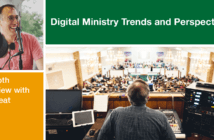What stewardship tasks require the attention of a pastor beginning ministry in a new congregational setting? Lovett H. Weems Jr. and Ann A. Michel of the Lewis Center Staff share a list of initial stewardship priorities for incoming pastors.
When a pastor begins ministry in a new church there is much to learn and many areas of ministry demand attention. While few new pastors will preach their first sermon on stewardship, certain steps taken in the early months of a new pastorate can help your stewardship ministry gets off to good start. Focusing on these initial tasks will lay the groundwork for stronger congregational stewardship and more generous giving as your ministry unfolds.
1. Take time to learn about your new congregation’s personality and practices related to stewardship and giving.
We are constantly amazed by the diversity of practice among different congregations and different faith traditions when it comes to stewardship and generosity. For example, an annual commitment campaign is something some churches take for granted. But there are fewer churches that use the pledge system than do not. So don’t make the mistake of assuming everything is just like it was in your previous church. Churches have varying traditions about such things as special offerings, fund raisers, electronic giving, reporting on giving, and other aspects of stewardship. These may change in the future, but first understand how things are done and, most importantly, why.
2. Get to know a broad range of people.
Good stewardship ministry is inherently relational, so spend time getting to know your congregants, where they are in their journey of faith and what’s important to them. Identifying those who exhibit the spiritual gift of giving is just as important as knowing those in the congregation who have a heart for mission, a passion for justice, or a strong prayer life. You can learn from all these people. This might involve reviewing their giving histories if you have access to giving records. If you do not have access to giving records, ask the person who does to prepare some figures about recent trends in giving over the past three years or so. Are more people giving or fewer? What difference did the pandemic make?
3. Don’t try to do it all yourself.
Pastors play a critical role in developing a culture of healthy stewardship, but they can’t do it all themselves, especially if they are new. From the beginning, develop laity as stewardship leaders. Pay special attention for those who exhibit characteristics that commend them as leaders in stewardship or finance. You are building a team from the beginning. After a season of listening and relationship building, you will be able to go back to these potential partners to explore an agenda for progress.
4. Get to know the current stewardship and finance leaders.
These are your key colleagues and allies. Get to know them as you learn about how things are currently done. Ask lots of questions. Avoid judgmental responses or expressions. Ask what they see as the most pressing issues in the coming months or year. Taking notes helps. Learn all you can. Always end by asking, “Are there others with whom I should talk?”
5. Get your own house in order.
You can’t lead where you haven’t gone yourself. So, spend some time reflecting on your own attitudes toward money, your personal finances, your own giving, and getting comfortable with faith’s teachings regarding money. You’ll have much more credibility as a stewardship leader if you can lead by example.
Related Resources
- The Right Start: Beginning Ministry in a New Setting Video Tool Kit
- 50 Ways to Improve Pastoral Transitions, a free resource from the Lewis Center
- Generosity, Stewardship, and Abundance: A Transformational Guide to Church Finance (Rowman and Littlefield, 2021) by Lovett H. Weems Jr. and Ann A. Michel
- Stewardship in Times of Transition by Angela Denker






